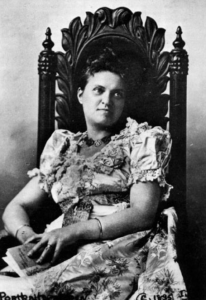Curtis Evans from Crime Reads looks at the rise and fall and restoration of Anna Katharine Green’s The Leavenworth Case. Support our news coverage by subscribing to our Kindle Nation Daily Digest. Joining is free right now!
The Leavenworth Case, American author Anna Katharine Green’s 1878 mystery novel (the first of more than thirty mystery novels and short story collections penned by this author), made quite a splash in its day, winning praise from the ringmaster of Victorian sensationalism, Wilkie Collins himself, and selling, so the story goes, over 750,000 copies in the decade and a half after its publication. Yet a couple generations later, at the beginning of the Golden Age of detective fiction (roughly 1920 to 1940), The Leavenworth Case had become, like a once resplendent Victorian mansion, one of those dreary and decayed landmarks on the literary landscape that people dutifully glance at before passing on to something altogether more modern and exciting. Although Leavenworth continued to stand derelict and neglected for most of the twentieth century, today industrious scholars have succeeded in restoring the novel’s reputation. A question remains, however, as to just how genuinely golden is that which now glitters.
At the height of the Golden Age of detective fiction critics (most of them, it must be allowed, men) pelted The Leavenworth Case with scornful commentary. Perusing a reprinted edition of Green’s first mystery novel in 1929, nearly three decades after he had originally read it, the great modernist writer T. S. Eliot, an avid consumer of mystery fiction who valued not only the work of the Victorian sensationalist Wilkie Collins but that of the modern detection purists like Freeman Wills Crofts, was moved to wonder why Arthur Conan Doyle’s Sherlock Holmes “reread so much better than The Leavenworth Case?” He noted disparagingly of Leavenworth that it “is simply popping over with sentiment” and “the sentimentality throws a spotlight on every technical flaw in the plot,” making the story a failure both as a pure novel and as a mystery. In Eliot’s view Anna Katharine Green in Leavenworth had fatally allowed the basest melodrama to overwhelm the novel’s detective interest.
At about the same time T. S. Eliot was looking back at Leavenworth and shuddering, the novelist and critic Arthur Bennett, in contrast with Eliot no fan of modern detective fiction, was taking a similar literary stroll down memory lane and reaching the same repulsed conclusion. Bennett likewise had read Leavenworth in his younger days. “I could remember nothing of The Leavenworth Case except that it gave me, as a youth, immense enjoyment,” Bennett wrote. “Now, in maturity,” he reflected sadly, “I have read it with difficulty; indeed I only got through it by the exercise of steely determination.” Bennett condemned both the “long-windedness and marked clumsiness of the narrative” and particularly “the inflated, maladroit and frequently ungrammatical style, especially in the dialogue, which is plenteous.” Again recalling T. S. Eliot, Bennett also argued that there was “little or no mystery” in Leavenworth, “for the reason that the book is soaked in sentimentality.” The author too obviously played favorites with the characters, in other words.
A few years later, in 1931, the English literary scholar H. Douglas Thomson took a look at Leavenworth in his Masters of Mystery: A Study of the Detective Story, the first book-length history of the detective fiction genre, and saw a literary edifice every bit as ungainly and unappealing as the one earlier decried by Eliot and Bennett. “The detection is singularly elementary,” he observed damningly. “The plot is hopelessly drawn out, and the melodrama is a sample of unnatural and stilted writing.”
By the 1940s, critical opinion had not altered. In his genre history Murder for Pleasure: The Life and Times of the Detective Story (1941), the American mystery critic Howard Haycraft deemed Green’s literary style “unbelievably stilted and melodramatic by modern standards” and “her characterization forced and artificial.” Similarly, in 1945 correspondence the great (and reliably snarky) hard-boiled crime writer Raymond Chandler damned Leavenworth with a terse pronouncement that naturally never found its way into the book’s blurbs: “Read it for laughs, if you haven’t [read it].”
It should be noted that some Golden Age women mystery writers held a much different opinion on this subject (not to mention others) from Raymond Chandler. The Queen of Classic Crime, Agatha Christie, fondly remembered Green’s landmark mystery, having read it, like T. S. Eliot and Arnold Bennett, at a young age. Similarly, another Golden Age woman crime writer, American Virginia Rath (1905-1950)—whose mysteries, though of course vastly less well known than Christie’s, are being reprinted—acknowledged Green’s childhood influence on her, recalling that while there had been “few books” at her family’s ranch in Colusa County, California there providentially were to be found on the shelves there some of Green’s detective novels, which she promptly “absorbed.” Another American crime writer from the period, the once very popular Carolyn Wells (1862-1942), was prompted to try her hand at detective fiction after devoutly reading Green as an adult.
Read full post on Crime Reads

